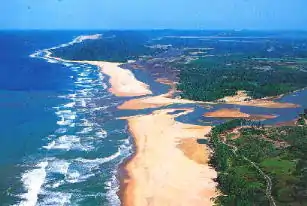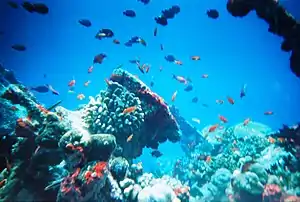Freshwater ecosystem
Freshwater ecosystems are a subset of Earth's aquatic ecosystems. They include lakes, ponds, rivers, streams, springs, bogs, and wetlands.[1] They can be contrasted with marine ecosystems, which have a larger salt content. Freshwater habitats can be classified by different factors, including temperature, light penetration, nutrients, and vegetation. Freshwater ecosystems have undergone substantial transformations over time, which has impacted various characteristics of the ecosystems. [2]
Freshwater ecosystems can be divided into lentic ecosystems (still water) and lotic ecosystems (flowing water).[1]
Limnology (and its branch freshwater biology) is a study about freshwater ecosystems.[1] It is a part of hydrobiology.
Original attempts to understand and monitor freshwater ecosystems were spurred on by threats to human health[3] (ex. Cholera outbreaks due to sewage contamination). Early monitoring focused on chemical indicators, then bacteria, and finally algae, fungi and protozoa. A new type of monitoring involves quantifying differing groups of organisms (macroinvertebrates, macrophytes and fish) and measuring the stream conditions associated with them.[4]
Threats to freshwater ecosystems
Five broad threats to freshwater biodiversity include overexploitation, water pollution, flow modification, destruction or degradation of habitat, and invasion by exotic species.[5] Recent extinction trends can be attributed largely to sedimentation, stream fragmentation, chemical and organic pollutants, dams, and invasive species.[6] Common chemical stresses on freshwater ecosystem health include acidification, eutrophication and copper and pesticide contamination.[7] Unpredictable synergies with climate change greatly complicate the impacts of other stressors that threaten many marine and freshwater fishes.[8]
Extinction of freshwater fauna
Over 123 freshwater fauna species have gone extinct in North America since 1900. Of North American freshwater species, an estimated 48.5% of mussels, 22.8% of gastropods, 32.7% of crayfishes, 25.9% of amphibians, and 21.2% of fish are either endangered or threatened.[6] Extinction rates of many species may increase severely into the next century because of invasive species, loss of keystone species, and species which are already functionally extinct (e.g., species which are not reproducing).[6] Even using conservative estimates, freshwater fish extinction rates in North America are 877 times higher than background extinction rates (1 in 3,000,000 years).[9] Projected extinction rates for freshwater animals are around five times greater than for land animals, and are comparable to the rates for rainforest communities.[6] Given the dire state of freshwater biodiversity, a team of scientists and practitioners from around the globe recently drafted an Emergency Action plan to try and restore freshwater biodiversity. [10]
Bio Current freshwater biomonitoring techniques focus primarily on community structure, but some programs measure functional indicators like biochemical (or biological) oxygen demand, sediment oxygen demand, and dissolved oxygen.[4] Macroinvertebrate community structure is commonly monitored because of the diverse taxonomy, ease of collection, sensitivity to a range of stressors, and overall value to the ecosystem.[11] Additionally, algal community structure (often using diatoms) is measured in biomonitoring programs. Algae are also taxonomically diverse, easily collected, sensitive to a range of stressors, and overall valuable to the ecosystem.[12] Algae grow very quickly and communities may represent fast changes in environmental conditions.[12]
In addition to community structure, responses to freshwater stressors are investigated by experimental studies that measure organism behavioural changes, altered rates of growth, reproduction or mortality.[4] Experimental results on single species under controlled conditions may not always reflect natural conditions and multi-species communities.[4]
The use of reference sites is common when defining the idealized "health" of a freshwater ecosystem. Reference sites can be selected spatially by choosing sites with minimal impacts from human disturbance and influence.[4] However, reference conditions may also be established temporally by using preserved indicators such as diatom valves, macrophyte pollen, insect chitin and fish scales can be used to determine conditions prior to large scale human disturbance.[4] These temporal reference conditions are often easier to reconstruct in standing water than moving water because stable sediments can better preserve biological indicator materials.
See also
References
- G., Wetzel, Robert (2001). Limnology : lake and river ecosystems (3rd ed.). San Diego: Academic Press. ISBN 978-0127447605. OCLC 46393244.
- Carpenter, Stephen R.; Stanley, Emily H.; Vander Zanden, M. Jake (2011-11-21). "State of the World's Freshwater Ecosystems: Physical, Chemical, and Biological Changes". Annual Review of Environment and Resources. 36 (1): 75–99. doi:10.1146/annurev-environ-021810-094524. ISSN 1543-5938.
- Rudolfs, Willem; Falk, Lloyd L.; Ragotzkie, R. A. (1950). "Literature Review on the Occurrence and Survival of Enteric, Pathogenic, and Relative Organisms in Soil, Water, Sewage, and Sludges, and on Vegetation: I. Bacterial and Virus Diseases". Sewage and Industrial Wastes. 22 (10): 1261–1281. JSTOR 25031419.
- Friberg, Nikolai; Bonada, Núria; Bradley, David C.; Dunbar, Michael J.; Edwards, Francois K.; Grey, Jonathan; Hayes, Richard B.; Hildrew, Alan G.; Lamouroux, Nicolas (2011), "Biomonitoring of Human Impacts in Freshwater Ecosystems", Advances in Ecological Research, Elsevier, pp. 1–68, doi:10.1016/b978-0-12-374794-5.00001-8, ISBN 9780123747945
- Dudgeon, David; Arthington, Angela H.; Gessner, Mark O.; Kawabata, Zen-Ichiro; Knowler, Duncan J.; Lévêque, Christian; Naiman, Robert J.; Prieur-Richard, Anne-Hélène; Soto, Doris (2005-12-12). "Freshwater biodiversity: importance, threats, status and conservation challenges". Biological Reviews. 81 (2): 163–82. CiteSeerX 10.1.1.568.4047. doi:10.1017/s1464793105006950. ISSN 1464-7931. PMID 16336747. S2CID 15921269.
- Ricciardi, Anthony; Rasmussen, Joseph B. (1999-10-23). "Extinction Rates of North American Freshwater Fauna". Conservation Biology. 13 (5): 1220–1222. doi:10.1046/j.1523-1739.1999.98380.x. ISSN 0888-8892.
- Xu, F (September 2001). "Lake Ecosystem Health Assessment: Indicators and Methods". Water Research. 35 (13): 3157–3167. doi:10.1016/s0043-1354(01)00040-9. ISSN 0043-1354. PMID 11487113.
- Arthington, Angela H.; Dulvy, Nicholas K.; Gladstone, William; Winfield, Ian J. (2016). "Fish conservation in freshwater and marine realms: status, threats and management". Aquatic Conservation: Marine and Freshwater Ecosystems. 26 (5): 838–857. doi:10.1002/aqc.2712. ISSN 1099-0755.
- Burkhead, Noel M. (September 2012). "Extinction Rates in North American Freshwater Fishes, 1900–2010". BioScience. 62 (9): 798–808. doi:10.1525/bio.2012.62.9.5. ISSN 1525-3244.
- https://academic.oup.com/bioscience/advance-article/doi/10.1093/biosci/biaa002/5732594
- Johnson, R. K.; Wiederholm, T.; Rosenberg, D. M. (1993). Freshwater biomonitoring and benthic macroinvertebrates, 40-158. pp. 40–158.
- Stevenson, R. Jan; Smol, John P. (2003), "Use of Algae in Environmental Assessments", Freshwater Algae of North America, Elsevier, pp. 775–804, doi:10.1016/b978-012741550-5/50024-6, ISBN 9780127415505
External links
| Wikimedia Commons has media related to Freshwater ecosystems. |

